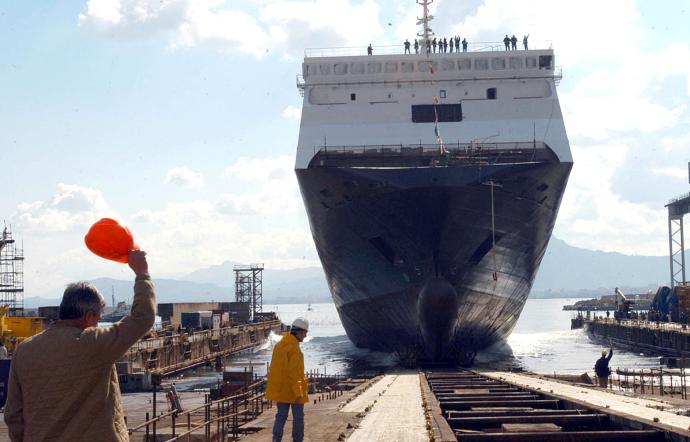(Lettera immaginaria di un marinaio siciliano)
Caro Beppe,
ti ricordi quando andavamo a pescarci il pranzo? Che sogno quel tappeto di vivi luccichii, prigionieri di piccole onde blu del mare sotto casa. Respiravamo l’aria azzurra del nostro paradiso e il dolce della zagara. Dagli scogli ci salutavano Marta e Linda, sbracciandosi in sorrisi d’amore, lanciavano baci e c’invitavano a tornare alle loro labbra.
Quanto tempo è passato? Mesi o secoli? Chiuso in questa latta ho perso il tempo mano a mano che la pelle si faceva sempre più bianca, ora sono anche dimagrito a fasoli e ragù puzzolente.
Ti scrivo senza sapere quando imbucherò questa lettera, ti scrivo senza sapere dove sei…volendo ti troveranno.
Marinai, non più pescatori.
Di Marta non ho notizie fresche, l’ultima lettera…anzi, le ultime otto lettere, le ho ricevute con due tue e una del parrinu: tutte insieme e con date già vecchie!
Don Luigi scrive che i miei stanno bene e Marta mi racconta di una vita tranquilla al paese. Il nuovo Podestà è un galantuomo, è il
papà di occhi ncruciati …dovresti ricordarti lei, se non il padre.
Marta mi scrive parole di lacrime e d’amore. Alle sue lacrime aggiungo le mie.
Tu sei sempre imbarcato? Della tua lettera ho letto ben poco: erano più le parti coperte da strisce di merda secca della censura…sei diventato un segreto di Stato! Forse anch’io ed è per questo che la posta non arriva più. Al rientro da ogni missione spero, comunque, di trovare qualche notizia dal paese e da te.
Da quando hanno saputo che ero il garzone del farmacista mi hanno nominato infermiere, l’equipaggio è ridotto al minimo indispensabile.
Non ho molto da fare in quel ruolo: ho curato qualche scottatura e ferita, più che altro devo curare tanta paura, che è la malattia più diffusa in missione, e qualche bozzu di chi ha misurato con la capa i piccoli spazi dei comparti. Mai nulla di serio, fortunatamente, perché l’infermeria è solo un armadietto nel quadrato ufficiali, non saprei che fare con un po’ di tintura e bende. Vero è che, per l’occorrenza, ci sono qualche laccio emostatico, un paio di pinze per ogni uso e un bisturi…prego Dio che non voglia mettermi alla prova! Forse ci sarà poco da curare se si può scoppiare come una bolla o morire di miciaciu senza un boccone d’aria.
A conti fatti preferisco i turni in cuffia ad ascoltare l’oceano, i pesci e le eliche grasse di qualche mercantile nemico. Io non ne ho ancora ascoltate, ma ho avuto la fortuna di sentire, per tempo, un’elica veloce e, probabilmente, malintenzionata: abbiamo smesso di respirare e le eliche sembravano formare una squadriglia sulla nostra testa. Loro dovevano avere altri impegni urgenti o sono stati così babbi da non trovarci. Lo “squalo”, il nostro Comandante, deve aver ben valutato che era meglio soprassedere o saremmo stati noi il loro pasto. Siamo stati “rapidi” ad acquattarci in modo “invisibili”.
Quando siamo risaliti, e il Comandante ha guardato nello specchio magico, il nemico era già troppo lontano per la nostra velocità. Forse questa parte della lettera la cancelleranno, ma le cose sono andate così… per una volta. Con lo Squalo ci siamo già ben distinti per il naviglio affondato.
Caro amico, andiamo per l’Oceano in questo bidone a caccia di ferro d’affondare e carne da macellare…Dio ci perdonerà? Ogni volta speriamo di non essere noi i vitelli da sacrificare!
Nelle notti senza Luna possiamo salire in coperta a respirare l’ aria dell’Oceano. Respiro profondamente, ma non sento nessun profumo…almeno non si sente puzza d’umani, di gasolio e cipolle….sento solo fresco sul viso e sono già, solo così, beato…felice d’esser vivo!
L’Oceano è solo uno sciacquio infinito e buio, almeno è quanto riesco a vedere. Forse dovremmo dargli rispetto, invece gli caghiamo dentro, appesi fuoribordo come sul trespolo di un pappaiaddu…forse è per questo che spesso s’incazza…e quando s’incazza, se non scendiamo come una balena, ci strappa le budedda…ma non è brutto come quando mirica o inglisi fan chioviri bumme.
Prego Sant’Agata, che mi raccomandi a Dio per non farmi morire qui, senza fussuni ne’ lapide.
Sott’acqua mi sembra di perdere l’anima, come se non scendesse con noi, solo il corpo rimane prigioniero nello scafo.
Lo Squalo ha visto qualcosa…trafficato questo mare grande! Debbo lasciarti, si va all’attacco!
Un abbraccio
Antonio
*Il mare lento
è nero e unto
di bava della morte.
Quando Nettuno
non accende la Luna
è tempo
di lupi affamati
che mordono
senza dare scampo.
Il mare lento
inghiotte,
con rantoli
di macabri sbuffi,
gli sconfitti
della notte,
mentre l’alba
festeggia
nuovi eroi.
(SCONFITTI ED EROI
di Romano Pisciotti)












































